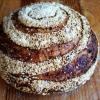 Chocolate flavored coffee.....what could be wrong with using some in a bread you ask? Nothing of course, so why not use it in a soaker as well ? That is exactly what I ended up doing. I normally leave the grains soaking for about 30 minutes to an hour, but in this case I left it over night for around 24 hours and the soaker grains sucked up all the coffee. When I mixed the final dough I decided to make this a very moist, high hydration dough so I didn't cut back on the additional coffee used and the end result as you will see was the most moist bread I've made to date that almost melts in your mouth.
Chocolate flavored coffee.....what could be wrong with using some in a bread you ask? Nothing of course, so why not use it in a soaker as well ? That is exactly what I ended up doing. I normally leave the grains soaking for about 30 minutes to an hour, but in this case I left it over night for around 24 hours and the soaker grains sucked up all the coffee. When I mixed the final dough I decided to make this a very moist, high hydration dough so I didn't cut back on the additional coffee used and the end result as you will see was the most moist bread I've made to date that almost melts in your mouth.
I used some rolled oats, cracked wheat and malted rye berries for the soaker and for the final dough I used durum, dark rye, white rye, European style flours and some roasted wheat germ. I added some barbecued potatoes and pistachio oil as well.
In order to make the soaker I used 285 grams of hot water and mixed it with the ingredients and let sit at room temperature for 24 hours.
For the starter, I refreshed my standard AP 65% hydration white starter the night before and used most of it in this bake.
Soaker
100 grams Rolled Oats
100 grams Cracked Wheat
50 grams Malted Rye Berries
285 grams Hot Mocha Coffee
Mix coffee in a bowl with other ingredients and let sit covered at room temperature for 24 hours.
Starter
71 grams Seed (Mine is 65% AP Flour Starter)
227 grams AP Flour
151 grams Water (85 - 90 degrees F.)
Mix seed with water to break up for a few seconds and then mix in flour until the starter form a smooth dough consistency. Put it in a lightly oiled bowl and loosely cover and leave at room temperature for at least 10 hours. The starter should double in volume. Put the starter in the refrigerator for up to 1-2 days or use it immediately.
Main Dough
Ingredients
425 grams Starter from above (all of the starter)
100 grams Durum Semolina Flour (KAF)
100 grams White Rye Flour
100 grams Pumpernickel Flour or Dark Rye Flour
150 grams European Style Flour (KAF) (Sub Bread Flour if you don't have this)
50 grams Roasted Wheat Germ
370 grams Mocha Coffee (90 degrees F.)
14 grams Sea Salt (or table salt)
209 grams Mashed Roasted Potatoes
10 grams Pistachio Oil (substitute any oil desired)
Procedure
I mixed the flours together with all the coffee except for 50 grams and let them autolyes for 30 minutes. I then added the levain, potatoes, oil and the soaker and the rest of the coffee with the salt and mixed on speed #1 for 1 minute and #2 for 4 minutes. I then did a stretch and fold, rested the dough uncovered for 10 minutes. I then did another stretch and fold, covered the dough and let it rest for 10 minutes. I did one more stretch and fold and put it in a lightly oiled bowl for 2 hours. I then put it in the fridge overnight.
The next day I let the dough sit out at room temperature for 1.5 hours. After 1.5 hours I formed it into loaves and put them in floured bannetons and let them rise covered for 2 hours.


Score the loaves as desired and prepare your oven for baking with steam.

I then baked on my oven stone with steam at 450 degrees until both loaves were golden brown and reached an internal temperature of 200 - 210 degrees F.
I had to bake this bread for almost 50 minutes since it was so moist and the final dough came out with an excellent crust and moist crumb.
Please visit my other blog for my older posts at www.mookielovesbread.wordpress.com.




- Crumb Close-up
































